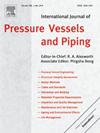Microstructure, mechanical properties, and corrosion resistance of dissimilar weld joints between SS304 and Inconel 600 welded using gas tungsten arc welding
IF 3.5
2区 工程技术
Q2 ENGINEERING, MECHANICAL
International Journal of Pressure Vessels and Piping
Pub Date : 2024-11-04
DOI:10.1016/j.ijpvp.2024.105356
引用次数: 0
Abstract
The microstructure, mechanical characteristics, and corrosion resistance of dissimilar gas tungsten arc welding (GTAW) joints of 304 stainless steel (SS304) to Inconel 600 (IN600) with Inconel 600, using ERNiCr-3 and ERSS308 filler metals were investigated. The welding process was executed at a current of 110 Amps under argon shielding gas, and all fabricated welds successfully joined SS304 to Inconel 600 without visible cracks or porosity at the weld metal interface. Microstructural analysis with optical and scanning electron microscopy revealed a mix of columnar and equiaxed dendritic structures in the weld zone for all samples. An unmixed zone was noted at the interface on the SS304 side when welded with Inconel 600 and ERNiCr-3, attributed to the differing melting points and chemical compositions of these fillers compared to SS304. The presence of Nb and Ti in the ERNiCr-3 filler facilitated the formation of TiC and NbC carbides in the welded metal structure, resulting in higher hardness compared to other specimens. Mechanically, the ERNiCr-3 welded sample exhibited superior hardness, with the highest microhardness values recorded in the ERNiCr-3 weld metal (197–207 HV) and higher values on the SS304 side (176–194 HV) compared to the IN600 side (164–176 HV). Corrosion tests, including Tafel and Electrochemical Impedance Spectroscopy, indicated that the ERNiCr-3 weld metal had better corrosion resistance than the IN600 weld metal. Due to the differences in chemical compositions of the base metals SS304 and IN600, it is necessary to consider an appropriate filler for welding these materials. ERNiCr-3 demonstrated increased hardness due to the formation of TiC and NbC carbides, along with enhanced corrosion resistance. These properties make it a promising material for industrial applications that require durability, strength, and resistance to corrosion, particularly in high-temperature or corrosive environments.
使用气体钨极氩弧焊焊接 SS304 和 Inconel 600 异种焊点的显微结构、机械性能和耐腐蚀性能
使用 ERNiCr-3 和 ERSS308 填充金属,研究了 304 不锈钢 (SS304) 与 Inconel 600 (IN600) 异种气体钨极氩弧焊 (GTAW) 接头的微观结构、机械特性和耐腐蚀性能。焊接过程在氩气保护下以 110 安培的电流进行,所有制造的焊缝都成功地将 SS304 与 Inconel 600 焊接在一起,在焊接金属界面上没有出现明显的裂缝或气孔。利用光学和扫描电子显微镜进行的微观结构分析表明,所有样品的焊接区都存在柱状和等轴树枝状混合结构。在与铬镍铁合金 600 和 ERNiCr-3 焊接时,SS304 侧的界面上出现了非混合区,这是因为这些填料的熔点和化学成分与 SS304 不同。ERNiCr-3 填料中 Nb 和 Ti 的存在促进了焊接金属结构中 TiC 和 NbC 碳化物的形成,使其硬度高于其他试样。在机械性能方面,ERNiCr-3 焊接试样表现出更高的硬度,ERNiCr-3 焊接金属的显微硬度值最高(197-207 HV),SS304 侧的硬度值(176-194 HV)高于 IN600 侧(164-176 HV)。包括塔菲尔和电化学阻抗谱在内的腐蚀测试表明,ERNiCr-3 焊缝金属的耐腐蚀性优于 IN600 焊缝金属。由于 SS304 和 IN600 母材的化学成分不同,焊接这些材料时必须考虑合适的填充物。ERNiCr-3 由于形成了 TiC 和 NbC 碳化物而提高了硬度,并增强了耐腐蚀性。这些特性使其成为一种很有前途的材料,适用于需要耐久性、强度和抗腐蚀性的工业应用,尤其是在高温或腐蚀性环境中。
本文章由计算机程序翻译,如有差异,请以英文原文为准。
求助全文
约1分钟内获得全文
求助全文
来源期刊
CiteScore
5.30
自引率
13.30%
发文量
208
审稿时长
17 months
期刊介绍:
Pressure vessel engineering technology is of importance in many branches of industry. This journal publishes the latest research results and related information on all its associated aspects, with particular emphasis on the structural integrity assessment, maintenance and life extension of pressurised process engineering plants.
The anticipated coverage of the International Journal of Pressure Vessels and Piping ranges from simple mass-produced pressure vessels to large custom-built vessels and tanks. Pressure vessels technology is a developing field, and contributions on the following topics will therefore be welcome:
• Pressure vessel engineering
• Structural integrity assessment
• Design methods
• Codes and standards
• Fabrication and welding
• Materials properties requirements
• Inspection and quality management
• Maintenance and life extension
• Ageing and environmental effects
• Life management
Of particular importance are papers covering aspects of significant practical application which could lead to major improvements in economy, reliability and useful life. While most accepted papers represent the results of original applied research, critical reviews of topical interest by world-leading experts will also appear from time to time.
International Journal of Pressure Vessels and Piping is indispensable reading for engineering professionals involved in the energy, petrochemicals, process plant, transport, aerospace and related industries; for manufacturers of pressure vessels and ancillary equipment; and for academics pursuing research in these areas.

 求助内容:
求助内容: 应助结果提醒方式:
应助结果提醒方式:


